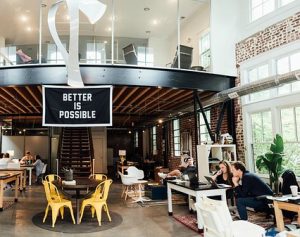For those who work outside the home, you spend more time in a potentially cold, square building than you do in your comfortable home. The average person works 8 hours a day, 5 days a week. That’s a lot of time to spend out of the house. We all know that the relationships we have at work can influence our home lives, but can the buildings themselves hold any power over how we sleep  or how we feel after we’ve punched out for the day? The answer to that is a bit astounding:
or how we feel after we’ve punched out for the day? The answer to that is a bit astounding:
The key to working better, sleeping better, and feeling better could be rooted in the design, maintenance, and operation of the buildings where we spend the majority of our time, a new Harvard study has found.
The national study, conducted by researchers at the Harvard T.H. Chan School of Public Health’s Center for Health and the Global Environment (CHGE) and SUNY Upstate Medical, is the first to show that working in high-performing, green-certified buildings can improve employee decision-making using objective cognitive simulations.
Researchers looked at 10 high-performing buildings in five cities across the United States, including Harvard’s double LEED Platinum Blackstone Southbuilding. The team collaborated with the Office for Sustainability (OFS) and Harvard Real Estate to use Blackstone as a “living laboratory” to study the relationship between building conditions and occupants’ productivity and well-being.
The study found that occupants in high-performing, green-certified office environments scored 26 percent higher on tests of cognitive function, had 30 percent fewer symptoms of sick building syndrome, and had 6 percent higher sleep quality scores than those in high-performing but noncertified buildings.
“Our University is the perfect test bed for innovation and research related to buildings and health. Through our partnership with the Office for Sustainability, we were able to kick off our study at the Blackstone buildings at Harvard before scaling our research to four other cities across the U.S.” said Piers MacNaughton, a postdoctoral fellow at Harvard Chan School and project manager for the study.
Twenty-four Harvard employees agreed to participate in the weeklong health assessment, which included two cognitive function tests, daily surveys, and wearing watches that tracked sleep quality. On each testing day, environmental conditions, such as thermal conditions and lighting, were also monitored in each participants’ workspace.
In addition to the overall effect from being in a better building, several specific factors were found to have impacts on participants’ cognitive function scores. The high-performing, green-certified buildings used in the study had environments more frequently within the thermal comfort zone defined by the American Society of Heating, Refrigerating, and Air-Conditioning Engineers (ASHRAE) organization, which resulted in 5.4 percent higher cognitive function scores. Brighter, blue-enriched lighting, such as daylighting, in the green-certified buildings was also associated with better sleep quality at night, which in turn led to better cognitive performance the following day. This finding supports research showing the impacts of lighting on circadian rhythm; a bigger contrast in daytime and nighttime light exposures can help regulate the release of melatonin, the hormone responsible for inducing sleep.
Via: http://news.harvard.edu/gazette/story/2017/02/study-opens-the-door-to-better-sleep-work-and-health/
It seems that no matter how hard we try to keep our work lives and our home lives separate, it’s interesting to see how the buildings that we actually work in can have such an impact on more than just our productivity. If you’re feeling extra sleepy at work, maybe you need to anonymously forward this study to your boss. Small changes like light and greenery can have such a huge impact on how we work and what we can accomplish. If you’ve got that boss whose constantly riding everyone and demanding production be sped up, this may be something they need to consider. Instead of that corner office for themselves, maybe they need to look at changing those lightbulbs.
